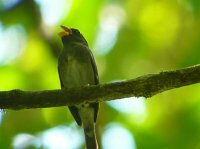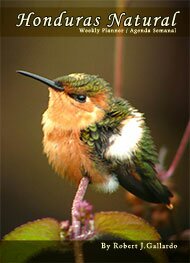Amongst this series of birds are listed those that stand out more than others due to their rarity, beauty, have an interesting behavior, unusual range or perhaps are easier to observe here than anywhere else in their range, or a combination of these aspects. This is an entirely subjective listing of species chosen by the author. For many of these species there is a photo, audio recording, distribution map and other pertinent information.
- Fasciated Tiger-Heron (Tigrisoma fasciatum)
- White-breasted Hawk (Accipiter chionogaster)
- Keel-billed Motmot (Electron carinatum)
- Blue-throated Motmot (Aspatha gularis)
- Turquoise-browed Motmot (Eumomota superciliosa)
- Tody Motmot (Hylomanes momotula)
- Harpy Eagle (Harpia harpyja)
- Honduran Emerald (Amazilia luciae)
- Sunbittern (Eurypyga helias)
- Black-crested Coquette (Lophornis helenae)
- Blue-Tailed Humminbird (Amazilia cyanura)
- Green-breasted Mountain-Gem (Lampornis sybillae)
- Lovely Cotinga (Cotinga amabilis)
- Snowy Cotinga (Carpodectes nitidus)
- Scarlet Macaw (Ara macao)
- Great Green Macaw (Ara ambigua)
- Resplendent Quetzal (Pharomachrus mocinno)
- Bushy-crested Jay (Cyanocorax melanocyaneus)
- Blue-and-white Mockingbird (Melanotis hypoleucus)
- Prevost's Ground-Sparrow (Melozone biarcuatum)
- Song Wren (Cyphorhinus phaeocephalus)
- Sedge Wren (Cistothorus platensis)
- Stripe-breasted Wren (Thryothorus thoracicus)
- Slate-colored Grosbeak (Pitylus grossus)
- Great Jacamar (Jacamerops aurea)
- Blue-crowned Chlorophonia (Chlorophonia occipitalis)
- Wedge-tailed Sabrewing (Campylopterus curvipennis)
- Lesser Ground-Cuckoo (Moroccocyx erythropygus)
- Singing Quail (Dactylortyx thoracicus)
- Ocealled Quail (Cyrtonyx ocellatus)
- Buffy Crowned Wood Patridge (Dendrortyx leucophrys)
- Yucatan Woodpecker (Melanerpes pygmaeus)
- Crested Owl (Lophostrix cristata)
- Fulvous Owl (Strix fulvescens)
- Great Potoo (Nyctibius grandis)
- Yellow-eared Toucanet (Selenidera spectabilis)
- American Dipper (Cinclus mexicanus)
- Long-tailed Manakin (Chiroxiphia linearis)
- Speckled Mourner (Laniocera rufescens)
- Wing-banded Antbird (Myrmornis torquata)
- Slate-colored Seedeater (Sporophila schistacea)
Fasciated Tiger-Heron (Tigrisoma fasciatum)
Although we recorded this species as early as 2006 in the upper Rio Platano drainage we have not been able to obtain a close up and clear photo until this year. On our April 2009 trip Andrew, James and I took a ½ day to walk up a nearby creek to see what we could find and ran across this very cooperative bird. James captured it beautifully. 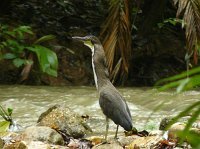
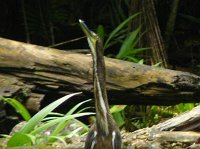
White-breasted Hawk (Accipiter chionogaster)
Although this bird is not recognized as having full species status by some authorities many of us do believe it to be completely different than the migratory Sharp-shinned Hawk (A. striatus) to which it is lumped. It is an uncommon to fairly common species throughout the highlands inhabiting pine and broadleaf forests. It may soar briefly, but spends much of its time perched awaiting to ambush prey.
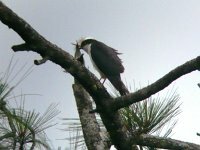
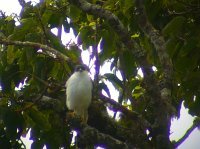
Keel-billed Motmot (Electron carinatum)
This species ranges from southeastern Mexico through Guatemala, Belize, northern and eastern Honduras, eastern Nicaragua to eastern Costa Rica.  It inhabits deep, lowland and pre-montane humid, broadleaf forest and only occasionally will it venture into young second growth vegetation adjacent to older growth. It is usually a solitary bird, but can occasionally be found in pairs.
It inhabits deep, lowland and pre-montane humid, broadleaf forest and only occasionally will it venture into young second growth vegetation adjacent to older growth. It is usually a solitary bird, but can occasionally be found in pairs.
The rainforests of Pico Bonito N.P. (Nombre de Dios mountain range) is perhaps one of the best and easiest places to observe this otherwise uncommon bird. It is also fairly common in the Mosquitia region, but more difficult to reach. It is often heard calling from deep within the rainforest, but very difficult to find. They can usually be brought in with a recording and are extremely responsive to its "aggression" call. Its call and that of the Broad-billed Motmot (E. platyrhynchum) are very similar and one's call will occasionally lure in the other species as I have observed on several occasions. Upon being taped in the Keel-billed will literally sneak in almost without being observed and perch in some vegetation where it can be difficult to see.
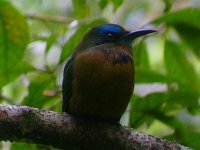
Distribution Map (click to enlarge)
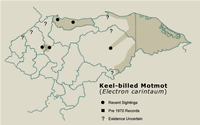
![]() AUDIO CLIP: Keel-billed Motmot (normal)
AUDIO CLIP: Keel-billed Motmot (normal)
![]() AUDIO CLIP: Keel-billed Motmot (agression)
AUDIO CLIP: Keel-billed Motmot (agression)
Blue-throated Motmot (Aspatha gularis)
This bird has the smallest range of all Mesoamerican motmots and is found in s. Mexico, c. Guatemala and Honduras. 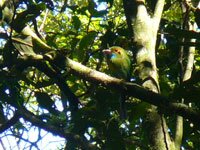 It inhabits montane forests usually above 1,500m. and is usually a solitary species.
It inhabits montane forests usually above 1,500m. and is usually a solitary species.
It was previously thought to be uncommon in Honduras, but I have actually found it to be locally common in a number of highland habitats and can usually be found on a daily basis and often seen very well. The southwestern highlands around Marcala are an exceptionally good place to observe this bird and it typically responds well to a recording. Like the Keel-billed Motmot, it usually flies in rapidly, perches and begins to call, often from high up in the subcanopy. Its green coloration and ventriloquil quality can make it difficult to see. On one occasion I observed two individuals with other birds mobbing two Fulvous Owls near dusk when it made some sort of "yodeling" sounds.
?In June and July 2009 two active nest sites were observed in the Opatoro-Guajiquiro area along steep road cuts. Adults were seen actively taking prey such as large crickets into one of the nest sites. At dusk an individual would approach the nest site and make a soft chuckling sound (similar to Blue-crowned Motmot or squirrel) before entering.
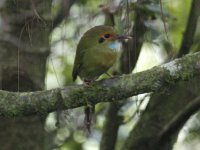

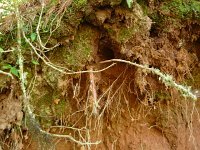
Distribution Map (click to enlarge)
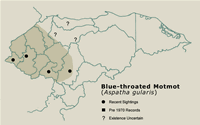
![]() AUDIO CLIP: Blue-throated Motmot
AUDIO CLIP: Blue-throated Motmot
Turquoise-browed Motmot (Eumomota superciliosa)
This most striking of the motmots is found in the Yucatan Peninsula, s. and e. Guatemala, throughout Honduras, w. Nicaragua and n.w. Costa Rica. Although it is the most common of motmots it is quite beautiful and the one that most everyone sees first upon coming to Mesoamerica.
Although it is the most common of motmots it is quite beautiful and the one that most everyone sees first upon coming to Mesoamerica.
It inhabits disturbed areas, lighter second growth and is often seen perched on wires and fences. It is often found in pairs and sometimes in small family groups of five after the young have fledged. They nest in holes any roadcuts, riverbanks, landslides and even archaeological ruins' walls. On a number of occasions I have observed individuals with a piece of leaf in their beaks when they would just hold there for quite some time. I have also seen the Blue-crowned Motmot (Momotus momota) do the same behavior.
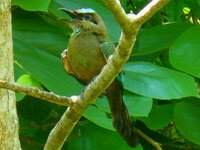
Distribution Map (click to enlarge)
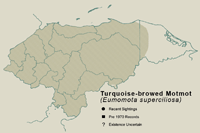
![]() AUDIO CLIP: Turquoise-browed Motmot
AUDIO CLIP: Turquoise-browed Motmot
Tody Motmot (Hylomanes momotula)
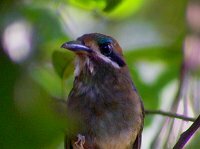 ?This, our smallest of motmots, is found throughout the country in appropriate humid, lowland and premontane broadleaf forest habitats. It is quite fond of steep, forested slopes where it probably nests. Recent records are from Lake Yojoa, Copan and Pico Bonito N.P. It ranges from s. Mexico to w. Columbia.?
?This, our smallest of motmots, is found throughout the country in appropriate humid, lowland and premontane broadleaf forest habitats. It is quite fond of steep, forested slopes where it probably nests. Recent records are from Lake Yojoa, Copan and Pico Bonito N.P. It ranges from s. Mexico to w. Columbia.?
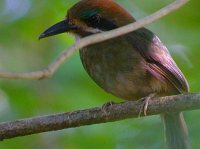
Harpy Eagle (Harpia harpyja)
The Harpy ranges from s.e. Mexico to South America. It inhabits undisturbed, large tracts of lowland broadleaf forest. It is the most powerful bird of prey on earth and it feeds on sloths, monkeys, guans, iguanas and other small mammals.
It is the most powerful bird of prey on earth and it feeds on sloths, monkeys, guans, iguanas and other small mammals.
In Honduras (and perhaps most of Central America) its stronghold are the rainforests of La Mosquitia (Departments of Colon, Olancho and Gracias A Dios) where extensive stands of rainforest can still be found. It lives side by side with other large raptors such as the Crested Eagle (Morphnus guianensis) and the Black-and-white Hawk-Eagle (Spizastur melanoleucus). Recent sightings and photographic records of the Harpy have been made along the Rio Platano and the Sutawala Valley (Tawahka-Asangni Bioshpere Reserve) and probably exists in other areas in La Mosquitia.
Distribution Map (click to enlarge)
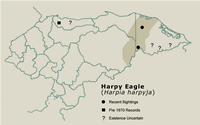
Honduran Emerald (Amazilia luciae)
This charming, medium-sized hummingbird is the only endemic species of bird known to exist in Honduras and one of the most threatened. 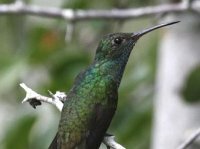 It inhabits arid, thorn scrub forest where it feeds on bromeliad flowers, cacti flowers and others as well as small insects.
It inhabits arid, thorn scrub forest where it feeds on bromeliad flowers, cacti flowers and others as well as small insects.
The only populations known to still exist are in the Agalta Valley (Dept. of Olancho) in remnant patches of suitable habitat and in the Aguan Valley (Dept. of Yoro) where there is now a special reserve that was decreed in 2005. In the reserve it is actually quite common and some Pygmy-owl tooting usually brings in one or more individuals.
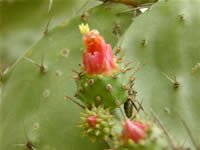 cactus flower
cactus flower
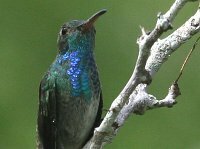
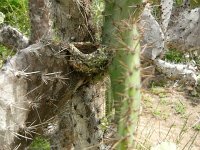
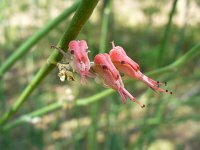
Distribution Map (click to enlarge)
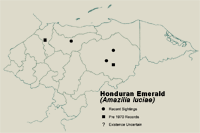
Sunbittern (Eurypyga helias)
 This wonderful bird inhabits rivers and creeks almost always associated with rainforest habitats. It is usually seen singly or in pairs. It is fairly common and found along the north coast and scattered locations in the interior to at least 1,200m. It ranges from Guatemala to Brazil.
This wonderful bird inhabits rivers and creeks almost always associated with rainforest habitats. It is usually seen singly or in pairs. It is fairly common and found along the north coast and scattered locations in the interior to at least 1,200m. It ranges from Guatemala to Brazil.
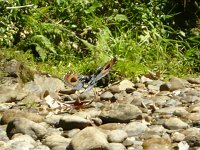
Black-crested Coquette (Lophornis helenae)
One of our smallest, but loveliest hummingbirds found in Honduras. This coquette is without a doubt a bird of special interest. Although it has been found at scattered localities in Honduras the Los Pinos visitors center is without doubt the best place to observe it, at least seasonally. There are usually 1 or 2 individuals that perch high up on leafless twigs on the lower terrace right near the entrance to the Waterfall Trail. It is found from s. Mexico to Costa Rica. It inhabits rainforest edge and canopy where it feeds on a variety of small, canopy flowers.

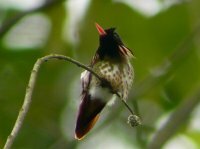
Blue-tailed Hummingbird (Amazilia cyanura)
 This lovely hummingbird occurs along the Pacific slope from extreme s. Mexico to n.w. Nicaragua and occasionally to Costa Rica. In Honduras there are scattered inland records. During the March `08 Choluteca Bird Count we found it to be quite common in the Cerro Guanacaure area. Many individuals were seen on a daily basis feeding on blooming Inga trees along creeks. To obtain this wonderful photo (actually a set of 4) I climbed on top of boulder adjacent to a blooming Inga and imitated a pygmy-owl call. This individual instantly came in and landed right in front of me. Picture perfect! We could only wish more birds were this cooperative.
This lovely hummingbird occurs along the Pacific slope from extreme s. Mexico to n.w. Nicaragua and occasionally to Costa Rica. In Honduras there are scattered inland records. During the March `08 Choluteca Bird Count we found it to be quite common in the Cerro Guanacaure area. Many individuals were seen on a daily basis feeding on blooming Inga trees along creeks. To obtain this wonderful photo (actually a set of 4) I climbed on top of boulder adjacent to a blooming Inga and imitated a pygmy-owl call. This individual instantly came in and landed right in front of me. Picture perfect! We could only wish more birds were this cooperative.
Green-breasted Mountain-Gem (Lampornis sybillae)
This medium-sized hummingbird exists in e. Honduras east of the Sula Valley and north-central Nicaragua-almost being a Honduran endemic. It inhabits mostly pre-montane and montane forest and edge, but has been documented near sea level during the non-breeding season.
In its highland habitat it is often seen feeding on bromeliad flowers from near ground level up to the sub canopy. One of the best and easiest places to see them are in La Tigra N.P.
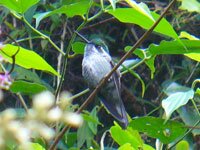

Distribution Map (click to enlarge)
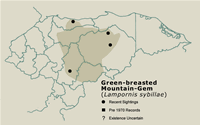
Lovely Cotinga (Cotinga amabilis)
This spectacular cotinga ranges from s.e. Mexico, n. Guatemala, s. Belize, Honduras, e. Nicaragua, e. Costa Rica and occasionally to Panama. It inhabits humid, broadleaf forest up into lower pre-montane forest. It is usually a solitary bird, but small groups can be seen together at fruiting trees. The female has a scaly pattern in hues of off white, light gray and browns. The striking metallic blue and purple males are often seen perching for extended periods of time in the forest canopy where they have wide vistas. This habit is common during the breeding season when they seem to have a "lookout" post. As they are almost entirely silent they are visually oriented. One Snowy Cotinga (Carpodectes nitidus) was observed along the Rio Platano as it flew approximately ½ mile across a valley to confront another Snowy and chased it up and over the mountain.
The rainforests of Pico Bonito N.P. is probably the best place in Honduras to observe this species where they can be seen almost on a daily basis at some locales throughout the year.
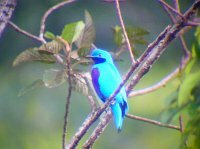
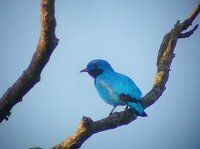

Distribution Map (click to enlarge)
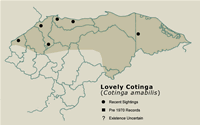
Snowy Cotinga (Carpodectes nitidus)
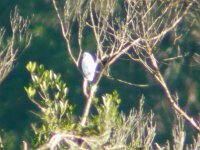 This stark white bird has only been recently recorded in eastern Honduras in the Rio Platano B.R. and the Tawahka-Asangni B.R. There are historic records from the La Ceiba area, but have not been recorded there in recent history. It typically inhabits the rainforest canopy singly or small feeding groups. It ranges from eastern Honduras to Panama.
This stark white bird has only been recently recorded in eastern Honduras in the Rio Platano B.R. and the Tawahka-Asangni B.R. There are historic records from the La Ceiba area, but have not been recorded there in recent history. It typically inhabits the rainforest canopy singly or small feeding groups. It ranges from eastern Honduras to Panama.
Scarlet Macaw (Ara macao)
This species ranges from s.e. Mexico locally to the Amazon basin in Brazil. It was once a more widespread bird even into the early part of the 20th century, but loss of suitable breeding and feeding habitat and capture for the pet trade has severely reduced their populations.
feeding habitat and capture for the pet trade has severely reduced their populations.
Like the Harpy Eagle, this macaw needs large tracts of lowland, broadleaf forest for its survival. It feeds primarily on nuts and fruits found in the forest canopy. A male and female will form a life long pair bond and will nest in a tree cavity. Their stronghold in Honduras, and probably most of Mesoamerica as well, is in La Mosquitia with some sightings still over the Agalta Valley in the Dept. of Olancho. Large flocks can still be seen in the rainforests of the Rio Platano Biosphere Reserve and lesser numbers in the Tawahka-Asagni Biosphere Reserve.
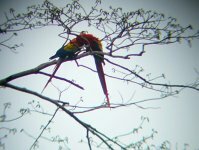
Distribution Map (click to enlarge)

Great Green Macaw (Ara ambiguus)
This beautiful macaw ranges fromeastern Honduras locally down to South America. From all records it is believed that this species has always been restricted to eastern Honduras.
The Great Green also inhabits large tracts of lowland, broadleaf forest and has similar habits as that of the Scarlet.
This species, however, is much less abundant, but can still be seen frequently in La Mosquitia singly or in small groups.
They have been recorded in the Tawahka reserve and in Rio Platano where they are more numerous.

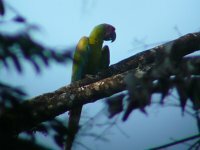
Distribution Map (click to enlarge)

Resplendent Quetzal (Pharomachrus mocinno)
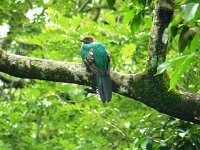 This species ranges from s. Mexico down through the highlands of Mesoamerica to w. Panama. It primarily inhabits montane forests above 1,500m., but will descend to near sea level in the months of Nov. to Jan. (Pico Bonito N.P. and elsewhere). They can sometimes be found in small groups as they gather to feed at "Aguacatillo" trees (Ocotea sp.).
This species ranges from s. Mexico down through the highlands of Mesoamerica to w. Panama. It primarily inhabits montane forests above 1,500m., but will descend to near sea level in the months of Nov. to Jan. (Pico Bonito N.P. and elsewhere). They can sometimes be found in small groups as they gather to feed at "Aguacatillo" trees (Ocotea sp.).
It is very widespread and fairly common throughout Honduras in its mountainous habitats. There are a number of places where they can be found in relative ease such as La Tigra N.P., La Muralla N.P., and the highlands of Marcala.
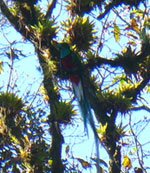


Distribution Map (click to enlarge)

Bushy-crested Jay (Cyanocorax melanocyaneus)
This jay has a relatively restricted range that includes c. Guatemala, n. El Salvador and most of Honduras outside of La Mosquitia to n. Nicaragua. It inhabits mixed woodland, coffee plantations, pine/oak forest, and cloud forest habitats to over 2,000m. They can occur in flocks of 20 or more and often associate with other bird species such as the Azure-hooded and Black-throated Jays, Black-headed Saltators and Yellow-backed Orioles. In their proper habitat they can be quite common. As many birders don't visit the countries where they are found it is often a "desirable" species.
It inhabits mixed woodland, coffee plantations, pine/oak forest, and cloud forest habitats to over 2,000m. They can occur in flocks of 20 or more and often associate with other bird species such as the Azure-hooded and Black-throated Jays, Black-headed Saltators and Yellow-backed Orioles. In their proper habitat they can be quite common. As many birders don't visit the countries where they are found it is often a "desirable" species.
They are very common in the hills around Copan Ruins, Cerro Azul Meambar N.P. and most forested, mountainous areas in Honduras, especially in pine clad hills.
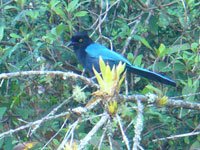
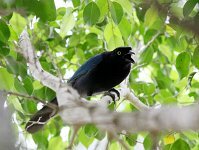
Distribution Map (click to enlarge)

![]() AUDIO CLIP: Bushy-crested Jay
AUDIO CLIP: Bushy-crested Jay
Blue-and-white Mockingbird (Melanotis hypoleucus)
This Mesoamerican endemic ranges from s. Mexico, c. Guatemala, patchy in El Salvador and w. Honduras.  It inhabits scrubby areas and is frequently found in bushes along roads in the highlands usually above 1,000m. They are often found in pairs and are usually difficult to observe well as they stick to their thick habitat. A tape playback will often draw it out for a better look.
It inhabits scrubby areas and is frequently found in bushes along roads in the highlands usually above 1,000m. They are often found in pairs and are usually difficult to observe well as they stick to their thick habitat. A tape playback will often draw it out for a better look.
In Honduras this species is common along the roads in the highlands around Marcala, La Paz. It is also seen along the road from San Juancito to El Rosario on the eastern side of La Tigra N.P.
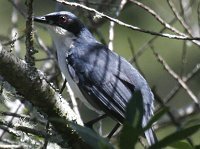
Distribution Map (click to enlarge)

Prevost's Ground-Sparrow (Melozone biarcuatum)
This Mesoamerican endemic ranges from southern Mexico,  central Guatemala, El Salvador and western Honduras.
central Guatemala, El Salvador and western Honduras.
It inhabits scrubby areas, farmland, coffee plantations, etc. from about 600 to over 2,000m.
It is typically seen on the ground probing leaf litter for insects.
This handsome sparrow is found in the Marcala highlands, Copan, Lake Yojoa and Pico Pijol N.P.
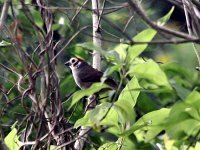
Distribution Map (click to enlarge)
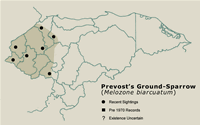
Song Wren (Cyphorhinus phaeocephalus)
This bird ranges from e. Honduras down to S. America. It inhabits deep, lowland broadleaf forest around sea level. It typically inhabits forest undergrowth. Its song in often heard within the forest and can usually be brought in with a recording. They are often found in small groups and their song is unforgettable, being likened by us as the Song Wren "polka".
In Honduras it is known only from the Rio Segovia and Rio Patuca areas. We found it to be fairly common in the Sutawala Valley within the Tawahka-Asangni Biosphere Reserve near the Nicaraguan border. It has yet to be found in the adjacent Rio Platano Biosphere Reserve.
Distribution Map (click to enlarge)
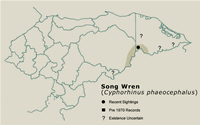
![]() AUDIO CLIP: Song Wren
AUDIO CLIP: Song Wren
Sedge Wren (Cistothorus platensis)
This small wren has a large range, but is found locally in Mesoamerica. It occurs in Canada, the United States, Mexico and  spottily through Mesoamerica down into S. America. It inhabits wet, grassy marshes with sedges. Many wetland areas may appear to be suitable habitat for this bird, but the wren is not present. The bird tends to remain within thick cover, but can be easily drawn out with a tape whence it will often perch on an exposed post or elsewhere and sing.
spottily through Mesoamerica down into S. America. It inhabits wet, grassy marshes with sedges. Many wetland areas may appear to be suitable habitat for this bird, but the wren is not present. The bird tends to remain within thick cover, but can be easily drawn out with a tape whence it will often perch on an exposed post or elsewhere and sing.
Historical records have found it in marshes around Puerto Lempira which are still extensive and the bird most likely still exists. They were also recorded in marshes around Siguatepeque whose current status in unknown. In December 2004 Irma and I found populations around La Esperanza, Dept. of Intibuca around 1,600 to 1,700m. in a number of marshes, many of which have been altered in one way or another, but with individuals remaining to persist.
. ?On a tour into northern Olancho Jason Thorn, Kevin Easley and R. Gallardo found a new site locality for this species. At least 7 individuals were heard and seen on July 10, 2009 approximately 19 kms. north of La Union, Olancho along the main dirt road and an adjacent side road leading east. They were all inhabiting tall grassy fields with light pine forest with no adjacent marshes.?

Distribution Map (click to enlarge)
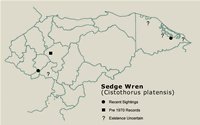
![]() AUDIO CLIP: Sedge Wren
AUDIO CLIP: Sedge Wren
Stripe-breasted Wren (Thryothorus thoracicus)
Prior to 2004 this Mesoamerican wren's range included 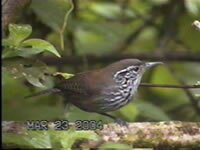 Nicaragua to c. Panama. It inhabits thick undergrowth of humid, broadleaf forest, especially along forest edge. Again, it is another bird that is usually heard before seen, but a recording will usually bring it in.
Nicaragua to c. Panama. It inhabits thick undergrowth of humid, broadleaf forest, especially along forest edge. Again, it is another bird that is usually heard before seen, but a recording will usually bring it in.
In March 2004 during our expedition to the Tawahka-Asangni B.R. we recorded this wren and the Black-throated Wren (T. atrogularis) for the first time in Honduras. Video and audio recordings were obtained of the Stripe-breasted to document our finding. This bird proved to be fairly common in the Sutawala Valley and has not yet been recorded in the Rio Platano basin.
Distribution Map (click to enlarge)
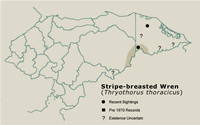
![]() AUDIO CLIP: Stripe-breasted Wren
AUDIO CLIP: Stripe-breasted Wren
Slate-colored Grosbeak (Pitylus grossus)
This birds' range previous to 1983 was from Nicaragua down into S. America. In 1983 Mickey Marcus, a former Peace Corps Volunteer, recorded it somewhere in the La Mosquitia area. It inhabits deep, humid broadleaf forest at low elevations. It can occur in thick second growth, but is more commonly found higher up in stands of larger trees. It sometimes accompanies mixed flocks such as with the White-throated Shrike-Tanager (Lanio leucothorax) and others. Its beautiful song echoes through the rainforest and can be easily brought in with a tape recording.
I have recorded it on the s. side of Ibans Lagoon in the Rio Platano B.R. in thick second growth. In the Sutawala Valley in the Tawahka-Asangni B.R. we found it to be fairly common to common and was heard or seen daily.

Distribution Map (click to enlarge)
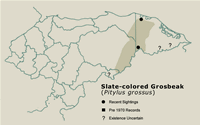
![]() AUDIO CLIP: Slate-colored Grosbeak 1
AUDIO CLIP: Slate-colored Grosbeak 1
![]() AUDIO CLIP: Slate-colored Grosbeak 2
AUDIO CLIP: Slate-colored Grosbeak 2
Great Jacamar (Jacamerops aurea)
This, the largest of Mesoamerican jacamars, previously ranged from Costa Rica down into S. America. It inhabits humid, lowland rainforest from older second growth to mature forest. It typically perches quietly, often on an exposed branch for prolonged periods in search of insects.  They are metallic green on top and rufous on its chest with the male having a white throat.
They are metallic green on top and rufous on its chest with the male having a white throat.
On our expedition to the Tawahka-Asangni B.R. in 2004 we found a male of this species right in our base camp. It would prove to be the best find of the trip. We obtained video VHC footage of it which was then digitalized. Only one individual was recorded and its frequency still remains unknown, but will probably prove to be fairly common there. It constitutes a range extension of some 500 km. and afterwards in 2005 was finally found in Nicaragua.?One individual was also recorded by voice by A. Vallely in the upper watershed of Rio Platano in June 2008?.
Distribution Map (click to enlarge)

Blue-crowned Chlorophonia (Chlorophonia occipitalis)
This beautiful Mesoamerican endemic ranges from Mexico to northern Nicaragua and occurs from sea level during winter months to well over 2,000m. It inhabits mostly pre-montane to montane forest habitats from second growth to mature forest and even ventures out to semi-open areas to feed on fruits.  It typically remains in the canopy and can be difficult to see due to its size and green coloration.
It typically remains in the canopy and can be difficult to see due to its size and green coloration.
I have found it to be a fairly common bird at a number of locales including Copan (Malcote Nature Reserve and Miramundo, Cerro Azul Meambar N.P. and Guisayote Biol. Reserve. The previous photo was taken at Cerro Azul where there was a male and female feeding on some type of strangler fig just above our heads near the visitor center.
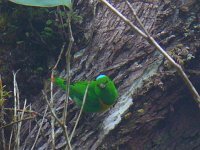

Distribution Map (click to enlarge)
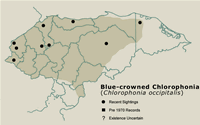
![]() AUDIO CLIP: Blue-crowned Chlorophonia 1
AUDIO CLIP: Blue-crowned Chlorophonia 1
![]() AUDIO CLIP: Blue-crowned Chlorophonia 2
AUDIO CLIP: Blue-crowned Chlorophonia 2
Wedge-tailed Sabrewing (Campylopterus curvipennis)
This large hummingbird ranges from e. Mexico, n. Guatemala, Belize to Honduras where it is found at several sites. Historically, this bird was first collected in Olancho in 1937 and was known only from that area (Monroe, 1968).

The male in the photo was taken in a backyard in Gualaco, Olancho in 1993. It has since been found in the Tawahka-Asangni Biosphere Reserve (Bonta and Anderson, 2002) and just recently in the vicinity of Cusuco N.P. by the Opwall Project at around 1,650m.
Distribution Map (click to enlarge)
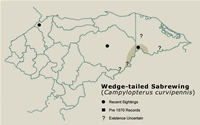
Lesser Ground-Cuckoo (Morococcyx erythropygus)
This species ranges from Mexico through northern Middle America down to northwest Costa Rica. It is terrestrial and inhabits arid to semi-arid scrub.
It is terrestrial and inhabits arid to semi-arid scrub.
They are usually found as solitary individuals and often heard, but difficult to observe. Their far carrying, rollicking whistle usually announces their presence. They will frequently respond to a tape playback and sneak in close to the observer, but often remain frustratingly hidden. It will occasionally jump up on a branch and begin to call incessantly, as when the above photo was taken. Sometimes it is seen early in the morning or late afternoon taking a dust bath on solitary roads.
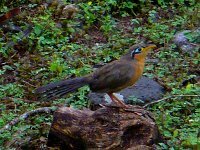
Distribution Map (click to enlarge)
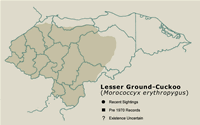
![]() AUDIO CLIP: Lesser Ground-Cuckoo
AUDIO CLIP: Lesser Ground-Cuckoo
Singing Quail (Dactylortyx thoracicus)
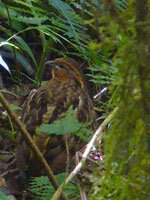
This quail is uncommon in Honduras, existing primarily in montane habitats above 800m. In Honduras it has been recorded only in the vicinity of La Tigra N.P. and Sierra de Agalta N.P. (Monroe, 1968). and in April 2008 in Celaque N. P. Gallardo (et.al). With patience it is fairly easy to observe in La Tigra N.P. especially along the trail that begins to drop down to the San Juancito side. It is typically found in pairs of small groups. Its loud, waivering voice can be heard from afar.
Distribution Map (click to enlarge)
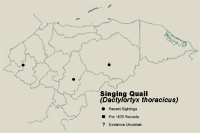
![]() AUDIO CLIP: Singing Quail
AUDIO CLIP: Singing Quail
Ocellated Quail (Cyrtonyx ocellatus)
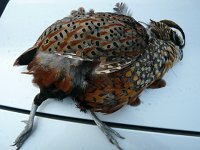 This Mesoamerican endemic ranges from southern Mexico south through north-central Nicaragua. The male is our most colorful quail and is one of the most coveted species in the region. To my knowledge and conversations with other tour company guides there is no single area where tourists can go to regularly observe it. In April 2009 en route to Rio Platano we found a dying male along the road just north of La Union, Olancho. On June 3, 2009 I encountered a male in the Uyuca Reserve near Zamorano along a road through the pine forest (see photo). During a bird tour to Olancho several observers found a female with chicks near the core zone of La Muralla N.P.
This Mesoamerican endemic ranges from southern Mexico south through north-central Nicaragua. The male is our most colorful quail and is one of the most coveted species in the region. To my knowledge and conversations with other tour company guides there is no single area where tourists can go to regularly observe it. In April 2009 en route to Rio Platano we found a dying male along the road just north of La Union, Olancho. On June 3, 2009 I encountered a male in the Uyuca Reserve near Zamorano along a road through the pine forest (see photo). During a bird tour to Olancho several observers found a female with chicks near the core zone of La Muralla N.P.

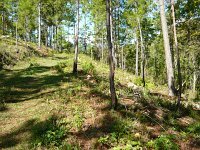
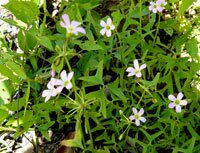
Buffy-crowned Wood-Partridge (Dendrortyx leucophrys)
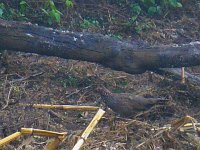 This prized bird is almost always one that appears on people?s ?target? list when they come to Honduras. Although widespread and actually quite common it is very difficult to observe, on most occasions. It is found throughout the highlands of most of Honduras and inhabits thick underbrush where it remains for most of the day. The bird in this photograph was seen near Guaquiquiro, La Paz after three site visits and was in an old corn field adjacent to blackberry thickets and brush. It was actually quite tame and cooperative and even allowed a scope view! Locals say it is easy to see in the early rainy season when small groups come out to feed on newly sprouted corn plants and is actually considered a pest.
This prized bird is almost always one that appears on people?s ?target? list when they come to Honduras. Although widespread and actually quite common it is very difficult to observe, on most occasions. It is found throughout the highlands of most of Honduras and inhabits thick underbrush where it remains for most of the day. The bird in this photograph was seen near Guaquiquiro, La Paz after three site visits and was in an old corn field adjacent to blackberry thickets and brush. It was actually quite tame and cooperative and even allowed a scope view! Locals say it is easy to see in the early rainy season when small groups come out to feed on newly sprouted corn plants and is actually considered a pest.
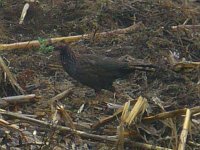
Yucatan Woodpecker (Melanerpes pygmaeus)
This bird can only be seen, in Honduras, on the island of Guanaja. There, it is fairly common in the broadleaf forest that rings the lower parts of the island and seems to have been little affected by Hurricane Mitch. It can be found singly, in pairs and occasionally accompanying mixed flocks.
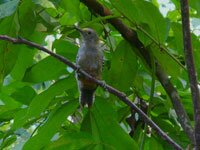

Distribution Map (click to enlarge)
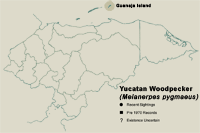
Crested Owl (Lophostrix cristata)
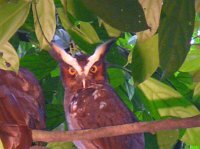 This magnificent owl inhabits rainforest. Although there are historical records from places like Cerro Puca and La Flor Archaga (Monroe, 1968) I am not aware if they still exist at those places. They have been recorded in recent history in Olancho, Rio Amarillo, Copan, the Rio Platano Biosphere Reserve and Pico Bonito N.P. It is consistently found at the Pico Dama encampment in Rio Platano and along the trail at the Lodge at Pico Bonito where this pair was found on a regular day roost.
This magnificent owl inhabits rainforest. Although there are historical records from places like Cerro Puca and La Flor Archaga (Monroe, 1968) I am not aware if they still exist at those places. They have been recorded in recent history in Olancho, Rio Amarillo, Copan, the Rio Platano Biosphere Reserve and Pico Bonito N.P. It is consistently found at the Pico Dama encampment in Rio Platano and along the trail at the Lodge at Pico Bonito where this pair was found on a regular day roost.
Fulvous Owl (Strix fulvescens)
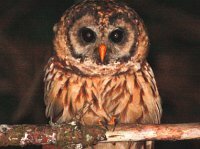 The Fulvous is a Mesoamerican endemic and ranges from southern Mexico through Guatemala throughout the highlands of Honduras. It is one of the most prized and coveted owls of C.A. One of the best places to find it is in the Opatoro-Guajiquiro highlands. Where they do exist they normally readily respond to audio playback.
The Fulvous is a Mesoamerican endemic and ranges from southern Mexico through Guatemala throughout the highlands of Honduras. It is one of the most prized and coveted owls of C.A. One of the best places to find it is in the Opatoro-Guajiquiro highlands. Where they do exist they normally readily respond to audio playback.
Great Potoo (Nyctibius grandis)
This large potoo ranges from Guatemala to S. America. It inhabits lowland rainforest and edge and along larger rivers. In these areas it generally perches on large limbs from where it hunts and calls. At day roosts it typically sits on a large horizontal limb under the forest canopy. On a number of occasions I observed small birds in the Parulidae and Trochilidae families approach the potoo while resting with its eyes closed. The potoo did not move or open its eyes.
It has been considered rare or uncommon by some authors in Honduras (Bonta & Anderson, 2003), but I have found it to be locally fairly common, especially around Pico Bonito N.P. I have many records of it both at night and at day roosts around the Lodge at Pico Bonito and other areas. This photo was taken at the nearby Cuero y Salado W.R. It was also recorded in the Rio Platano B.R. in Aug. 2006 north of Las Marias.


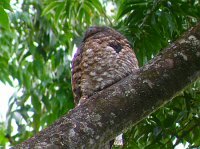
Distribution Map (click to enlarge)
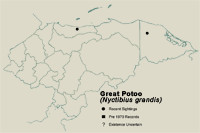
Yellow-eared Toucanet (Selenidera spectabilis)
This beautiful toucanet is generally uncommon to rare in Central America and ranges from Honduras, east of the Honduran Depression, to S.America and is typically difficult to find. All known sightings of this species come from broken terrain within lowland, humid rainforest.
Most records for Honduras come from Pico Bonito N.P. in the vicinity of the Bejuco waterfall trail along the Cangrejal River (J. Salaverri, pers. comm.) and occasionally the Lodge at Pico Bonito. There are historical records from Lancetilla Botanical Gardens (Monroe, 1968), but I have not personally seen it there recently. I have also found it several times in the Rio Platano B.R.; near the village of Limonal along the Sico River, a pair in (Aug./07) along a trail near Pico Dama just south of Las Marias and a pair and a group of five at the Pico Dama camp. The photos were taken of this very cooperative male and female pair along the trail to Pico Dama.
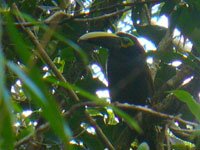
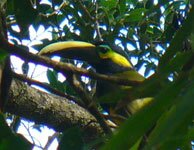
female male
Distribution Map (click to enlarge)
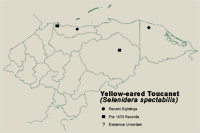
American Dipper (Cinclus mexicanus)
There are very few recent records of this species in Honduras which include one unsubstantiated record from Rio Platano (D. Anderson) and Celaque N.P. There is a historical record for San Juancito (at the base of La Tigra N.P.) in 1951 (Monroe, 1968). It is unknown if it still exists there as the contamination from the old mining industry may have wiped out the species. At least in Celaque N.P. they are known to breed along the main river that leads from the main park entrance up past the visitor center.

Long-tailed Manakin (Chiroxiphia linearis)
 This has to be the most striking manakin in Central America. The male has long, wiry tail feathers, glowing blue back and orange feet, and a red cap. The red cap when seen front on sticks out at the sides and has the appearance, for better words, as a Chinese hat. The female, as in most cases, has a lot more to be desired. It occupies the Pacific slope from s. Mexico to Costa Rica. In Honduras it is restricted, as far as I`m aware, to the Dept. of Choluteca on Cerro Guanacaure. During the March `08 Choluteca Bird Count we found this species to be actually quite common in the monsoon forests. I was also fortunate enough to witness and take digital video of the amazing courtship ritual that is the hallmark of manakins throughout. At one point there were four adult males ?dancing? for three females as one juvenile male watched. It has to be one of the most incredible courtship spectacles to be observed in the Neotropics.
This has to be the most striking manakin in Central America. The male has long, wiry tail feathers, glowing blue back and orange feet, and a red cap. The red cap when seen front on sticks out at the sides and has the appearance, for better words, as a Chinese hat. The female, as in most cases, has a lot more to be desired. It occupies the Pacific slope from s. Mexico to Costa Rica. In Honduras it is restricted, as far as I`m aware, to the Dept. of Choluteca on Cerro Guanacaure. During the March `08 Choluteca Bird Count we found this species to be actually quite common in the monsoon forests. I was also fortunate enough to witness and take digital video of the amazing courtship ritual that is the hallmark of manakins throughout. At one point there were four adult males ?dancing? for three females as one juvenile male watched. It has to be one of the most incredible courtship spectacles to be observed in the Neotropics.
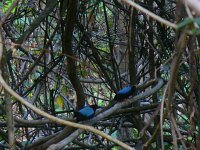
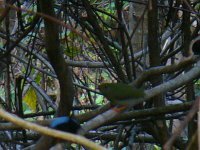

Speckled Mourner (Laniocera rufescens)
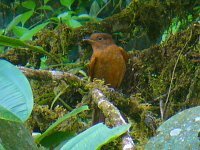 This species is considered as ?rare? in Honduras by some authors, but I have found it to be actually common locally in the upper drainage of the Rio Platano. Individuals are often heard or seen daily from the put-in site in the upper drainage all the way down to the Cuyamel River. Its distinctive call (reminiscent of beginning notes of White-breasted Wood-Wren) are loud and carry far in the forest interior.
This species is considered as ?rare? in Honduras by some authors, but I have found it to be actually common locally in the upper drainage of the Rio Platano. Individuals are often heard or seen daily from the put-in site in the upper drainage all the way down to the Cuyamel River. Its distinctive call (reminiscent of beginning notes of White-breasted Wood-Wren) are loud and carry far in the forest interior.
Wing-banded Antbird (Myrmornis torquata)
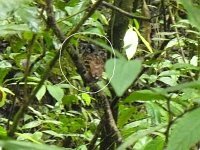 This species is scarce in most of Central America, but was on our target list of birds to be found as its former range was north to eastern Nicaragua. During the June 2008 Rio Platano Biological Expedition John Ascher bumped into what he identified was this bird while lost in the rainforest at the La Cueva camp in the upper drainage. After finding his way back to camp he and Andrew Vallely went back into the rainforest to try and relocate the bird, but had no luck.
This species is scarce in most of Central America, but was on our target list of birds to be found as its former range was north to eastern Nicaragua. During the June 2008 Rio Platano Biological Expedition John Ascher bumped into what he identified was this bird while lost in the rainforest at the La Cueva camp in the upper drainage. After finding his way back to camp he and Andrew Vallely went back into the rainforest to try and relocate the bird, but had no luck.
In April 2009 Andrew, James Adams and I rafted the river with J. Salaverri and Umberto with finding this bird in mind. Since we only had one raft we moved quickly and were able to spend two nights at the La Cueva camp. We found the likely spot and after ?fishing? with an audio recording we quickly found a single male. It readily came in close and on a second attempt James got our only photo of this male. It inhabited primary forest with limestone outcroppings. A recent search (March 2010) in the same spot did not turn up the bird.
Slate-colored Seedeater (Sporophila schistacea)
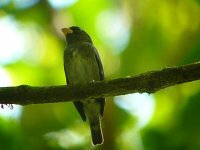 This seedeater is unusual in that it is highly nomadic and wanders widely, mostly in search of seeding bamboo. To my knowledge it has only been recorded in Honduras but only 4 times (Marcus 1983, Gallardo 2002,2003,2010). The 2003 and 2010 sightings represented a big influx of birds in the Rio Platano basin upriver from Las Marias. On both occasions there was a large number of singing males which were most likely in breeding behavior.
This seedeater is unusual in that it is highly nomadic and wanders widely, mostly in search of seeding bamboo. To my knowledge it has only been recorded in Honduras but only 4 times (Marcus 1983, Gallardo 2002,2003,2010). The 2003 and 2010 sightings represented a big influx of birds in the Rio Platano basin upriver from Las Marias. On both occasions there was a large number of singing males which were most likely in breeding behavior.
